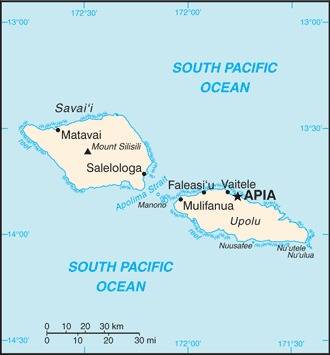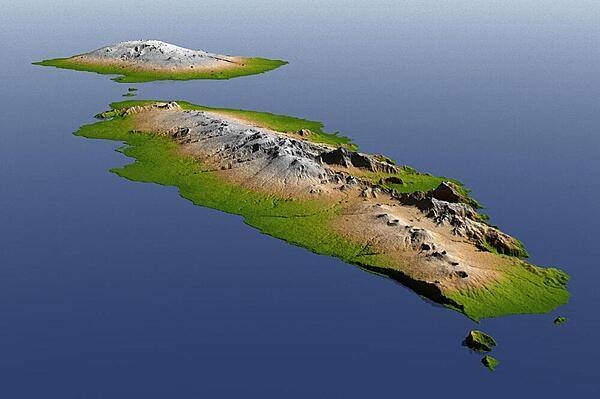49 Samoa

Red with a blue rectangle in the upper hoist-side quadrant bearing five white, five-pointed stars representing the Southern Cross constellation. Red stands for courage, blue represents freedom, and white signifies purity.
Flag courtesy of the CIA World Factbook

Map courtesy of the CIA World Factbook

The topography of Savai’i (background) and Upolu (forefront), the two large islands of the Independent State of Samoa, is well shown in this color-coded perspective view from a NASA Shuttle Radar Topography Mission.
Photo courtesy of the CIA World Factbook
Government
According to Britannica, in 1962 Samoa promulgated its constitution as the first independent microstate in the Pacific region, and in 1970 it joined the Commonwealth. Samoa has a parliamentary government that blends Samoan and New Zealander traditions. The constitution originally provided for a constitutional monarchy under two coheads of state, with the provision that when one died (as happened in 1963), the other would continue as sole monarch and head of state for life. After the death of the second monarch, heads of state were elected by the Legislative Assembly (Fono Aoao Faitulafono) to five-year terms, limited to two terms. The prime minister is elected by the assembly and appoints a cabinet from among its members. The Legislative Assembly has 51 members, but up to 5 additional seats may be added in order to ensure that women make up at least 10 percent of the legislature. (The requirement is considered fulfilled if women fill 5 of the 51 seats.) Members of the Legislative Assembly are directly elected and must be Samoan matai (chiefs).
Samoan local government is the responsibility of more than 360 villages in 11 administrative districts, five of which are based on Upolu, A‘ana, Aiga-i-le-Tai (with Manono and Apolima islands), Atua, Tuamasaga, and Va‘a-o-Fonoti, and six on Savali, Fa‘asaleleaga, Gaga‘emauga, Gaga‘ifomauga, Palauli, Satupa‘itea, and Vaisigano. Each of Samoa’s several thousand aiga (extended families) designates at least one matai to lead and represent it; the matai, in turn, form village councils to administer local affairs.
The justice system is headed by a Supreme Court, whose chief justice is appointed by the head of state on the advice of the prime minister. Supreme Court judges also preside over the Court of Appeal. Among the lower courts are the Magistrate’s Court, which hears most criminal cases, and the Lands and Titles Court, which handles civil matters.
Civil Aviation Division of the MWTI
The primary legislation governing civil aviation in Samoa is the Civil Aviation Act 1998 with the Civil Aviation Rules and Regulations 2000 as the secondary legislations. The Ministry of Transport (MOT) is designated under the Act as the Civil Aviation Authority for Samoa, a role now with the Ministry of Works, Transport & Infrastructure (MWTI). The Civil Aviation Division of the MWTI is tasked with enforcing the 1998 Civil Aviation Act, Civil Aviation Rules (CARs) & Regulations 2000 and advising the CEO on civil aviation policies to ensure Samoa complies with its obligations under ratified International Conventions, Treaties and Agreements. Under its legal mandates, the Civil Aviation Division has responsibility for the safety oversight of all Civil Aviation Activities in Samoa.
Pacific Aviation Safety Office (PASO)
The Pacific Aviation Safety Office (PASO) is an international organization providing quality aviation safety and security service for Member States in the Pacific.
PASO is the sole international organization responsible for regional regulatory aviation safety oversight service for the 10 Pacific States who are signatories to the Pacific Islands Civil Aviation Safety and Security Treaty (PICASST).
The current PICASST signatories are the Pacific nations of Cook Islands, Kiribati, Nauru, Niue, Papua New Guinea, Samoa, Solomon Islands, Tonga, Tuvalu, and Vanuatu. Associate Members of PASO are Australia, Fiji and New Zealand. Government representatives from these nations make up the PASO Council.
Airspace
SkyVector – Google Maps – ADS-B Exchange
ICAO countries publish an Aeronautical Information Publication (AIP). This document is divided into three parts: General (GEN), En Route (ENR) and Aerodromes (AD). ENR 1.4 details the types of airspace classes they chose to adopt from classes A through G.
Drone Regulations
Advanced Air Mobility (AAM) Regulations & Policies
Advanced Air Mobility (AAM) News
None found by the author.
However, should you, the reader, happen to stumble across something to the contrary, please email the author at FISHE5CA@erau.edu and you may be mentioned in the ACKNOWLEDGEMENTS section of this book by way of thanks for contributing to this free eBook!
Short Essay Questions
Scenario-Based Question
You have been hired by a Drone Startup Company. Your boss has immediately assigned this job to you.
They need you to prepare a one-page memo detailing the legalities of using a drone in Samoa.
They need you to mention any national laws and local ordinances.
They specifically want to know what airspace (insert pictures) you will be operating in and whether or not you need an airspace authorization.
Does it matter whether or not you are a citizen of the country?
Lastly, there is a bonus for you if, as you scroll through this chapter, you find any typos or broken links!
Short Essay Questions
- What are the drone categories?
- How is registration addressed?
- How is remote ID addressed?
- What are the model aircraft rules?
- What are the commercial drone rules?
- Are there waivers or exemptions to the rules? If so, for what?
- Would you share a link to an interactive airspace map?
- How is BVLOS addressed?
- How can you fly drones at night?
- How can you fly drones over people?
- Where do you find drone NOTAMs?
- What are the rules for drone maintenance?
- What are the rules for an SMS program?
- What are some unique rules not mentioned above?
- What are the C-UAS rules?
- What are the AAM rules?

